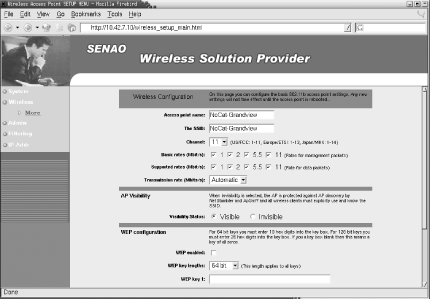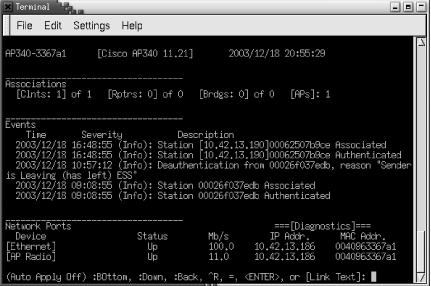| With the explosion in Wi-Fi popularity, a corresponding plethora of vendors and equipment choices have surfaced. There are an amazing number of access points, but there are also wireless routers, wireless bridges, wireless-to-Ethernet bridges, and some Linux- powered equipment as well. 5.2.1 Access Points In Chapter 1, we covered the basics of 802.11 and the two modes of operation it supports. Infrastructure Mode, the most common mode, requires the use of a wireless access point. Most access points on the market share a common number of connectors: at least one external antenna, one Ethernet port, status LEDs, and an external power supply or wall wart. Other features you might find on some models include connectors for attaching external antennas, a reset button to return the unit to factory settings, multiple Ethernet ports, and support for Power Over Ethernet (POE). Power over Ethernet If you're familiar with network cabling, you know that Ethernet uses only two pairs of the wire inside a standard Category 5 cable. Pairs 1-2 and 3-6 are used, leaving 4-5 and 7-8 available. POE sends DC power over these unused pairs, enabling the placement of access points or other network hardware away from power sources. This is especially useful if you need to mount your access point on a pole, on the ceiling, or in other inaccessible places. Run CAT5 wire rather than going to the trouble of running electrical conduit. You can now supply both Ethernet and power to the unit. In June 2003, the IEEE released its specification for POE, 802.3af. More information on this standard can be obtained from the IEEE web site at http://www.ieee802.org/3/af/. The IEEE standard is only a few months old as of this writing, so most POE equipment available for purchase will not meet the standard. There are excellent documents from community wireless organizations available on building POE equipment. A few good examples are the Bay Area Wireless Users Group (BAWUG) page at http://www.bawug.org/howto/hacks/PoE/ and the NYCWireless page at http://www.nycwireless.net/poe/. In order to make POE work, you need a power injector, which is referred to in the 802.3af standard as the Power Sourcing Equipment (PSE), and a corresponding unit on the other end. The standard refers to the end device as a PD. If your equipment is designed to support POE out of the box, you need only a PSE. This unit typically has three jacks : DC power, Ethernet IN, and Ethernet/power OUT. Connect power, Ethernet from your network, and then connect Ethernet/power OUT to the Cat 5 cable running to your Powered Device. On the other end, if your equipment does not natively support POE, what you need is a splitter, a reverse of the PSE. It also has three jacks: Ethernet/power IN, Ethernet OUT, and DC power OUT. This device takes your incoming Ethernet/power and splits it again for connection to your device. WARNING: unless you have electrical and LAN wiring experience, making your own POE equipment can be dangerous or fatal to you and your equipment. |
Once you get past the outside connectors, the internal features of access points begin to vary widely. There are all sorts of devices on the market, ranging from simple home-use devices to enterprise-class units designed for large deployments. The following list describes various manufacturers and some of their equipment: -
- Apple AirPort
-
This was one of the first access points available. Apple brought this access point and the AirPort client cards to market before the 802.11b standard was finalized. The internals of the unit are built by Lucent/Orinoco and are identical to the Orinoco RG-1100. Note that this applies only to the original AirPort model. The second model (Snow) and the subsequent AirPort Extreme are based on a different processor. Chapter 6 covers some utilities that can be used to reflash the firmware on these units, allowing you to swap personalities and even to run Linux on them. As shown in Table 5-2, the AirPort and the RG-1100 are not configurable out of the box from Linux. This is easily remedied. Also, early versions of the AirPort had problems with non-Apple wireless cards. Many of these cards would not associate with the access point. This has since been fixed through firmware updates. -
- Orinoco AP-series
-
This series includes some of the most popular enterprise-class access points. The AP-500 has a single radio inside, an Orinoco PC Card. The AP-1000 was the first access point to feature two radios, again both in PC Card format. Orinoco access points have a wide array of features: MAC address filtering, network protocol filtering to enforce such policies as preventing IPX from traversing your wireless network, support for RADIUS authentication, and custom power over Ethernet adapters. Orinoco calls these units "Active Ethernet," and they are available in 1-, 6-, and 12-port models, so that you can power up to 12 access points using the same POE adapter. More recent models include the AP-2000, the successor model to the AP-1000 (which features upgradeability to 802.11a or 802.11g, or both), giving you a tri-mode access point with all of the Orinoco features, and the AP-2500, which is a "hotspot-in-a-box" model that includes a captive portal and many other features necessary for setting up a wireless hotspot. -
- Linksys
-
Linksys made a huge splash with its WAP-11 access point when it was first introduced. It had a good feature set and external antenna adapters, and was priced for the home market. Unfortunately, it is mainly configurable through a Linksys-specific setup program, which runs on Windows. There is an SNMP utility for Windows, and Linksys did publish an SNMP Management Information Base (MIB) for Linux/Unix users. (An MIB is one or more text files that allow Linux's SNMP tools to generate human-readable statistics from SNMP management strings.) Later Linksys models still continue to ship with Windows-only setup programs. However, they now offer web-based configuration that is easily accessible from Linux web browsers. Much of the other consumer-level wireless gear can be placed in the same area as Linksys. D-Link, SMC, and Netgear all offer models with nearly identical features and price points. -
- EnGenius/Senao
-
Early in 2002, rumors surfaced of a 200 mW radio card. While one manufacturer, Zcomax, had made these available, they were hard to find and were expensive. At that point, with a few exceptions, most radio cards and access points were powered by 30 mW radios. You can imagine how excited the wireless users were at the thought of being able to expand their range. Today, EnGenius/Senao offers several access points for indoor and outdoor use, all with 200 mW radios. Along with Cisco, it is one of the few vendors to support Telnet access for configuration. Figure 5-1 shows a sample web-based configuration screen from an EnGenius access point. -
- Tranzeo
-
Tranzeo is one of a number of vendors focused on supplying wireless Internet service providers. Tranzeo's equipment is designed to work outdoors and comes in many models, some of which include an integrated directional panel antenna. Its access points are accessible via Telnet as well as a Windows-based GUI. Many of its models offer some routing features (see Section 5.2.2 later in this chapter). -
- Cisco
-
The 800- pound gorilla of networking, Cisco, entered the 802.11 market when it acquired Aironet in late 1999. Aironet was already a manufacturer of 802.11 first-generation equipment, and Cisco bought Aironet at precisely the right time to take advantage of the 802.11b introduction. Cisco's access points, as expected, integrate extremely well into a Cisco network. They have a wide feature set and compare well with the products from Orinoco in the enterprise space. Also, as expected, the Cisco units all support Telnet as well as web-based configuration. Figure 5-2 shows the main Telnet screen from a Cisco AP. Figure 5-1. Web-based configuration for an EnGenius/Senao access point  Figure 5-2. Cisco Telnet configuration window  5.2.2 Wireless Routers The line between an access point and a wireless router is very blurry. Many devices sold as access points include routing features. For example, the Apple AirPort models offer Network Address Translation and a DHCP server. Wireless routers are basically a combination of home ADSL/cable routers and a wireless access point. There are some key differences, however, between most of the wireless routers now available and standard access points. You can expect to find at least some of these features on a wireless router: -
- Routing protocol support
-
RIP or RIPv2 on many models -
- Network services
-
DHCP, DNS, and others -
- Encryption support
-
Client or router support for IPSec and PPTP VPNs -
- Limited firewalls
-
IP masquerading and some packet filtering -
- Port forwarding
-
Sending certain TCP or UDP ports to a specific machine These units are really designed for home or small-office use. You'll find that the larger network vendors such as Cisco don't manufacture this type of hardware, because they want you to purchase one of their full-fledged routers. Security in many models of these routers is also questionable. The bugtraq mailing list at http://www.securityfocus.com/archive shows you that the number of vulnerabilities in this type of consumer hardware is fairly high. While these units increase security compared to a standalone PC connected to a DSL modem, they are not the end-all be-all for network security. Wireless routers are available from almost any manufacturer that also makes access points. An alternative to commercial wireless routers is to build your own using Linux. Chapter 6 covers this topic in detail. 5.2.3 Wireless Bridges Perhaps the most well-known wireless bridge is the Linksys WET-11. A wireless bridge takes in an Ethernet signal and repeats it out to a wireless network, and vice versa. A wireless bridge is not an access point, however. The bridge is only capable of acting as an infrastructure client to a distant access point. The practical uses of these devices abound. If you want to connect your Ethernet-enabled PC to your wireless network, attach it to a bridge. Wireless ISPs can install a wireless bridge as their customer premises equipment (CPE), allowing the customer to have a wired Ethernet network in her home, bridged wirelessly to a remote access point. Any device with an Ethernet port can be added to a wireless network using a wireless bridge. As with wireless routers, most of the companies that manufacture access points have at least one model of wireless bridge available. If you want an outdoor wireless bridge with an integrated antenna, excellent models are available from Tranzeo at http://www.tranzeo.com. Models for home or office use can be found from Linksys, D-Link, SMC, and all the other usual suspects . |

